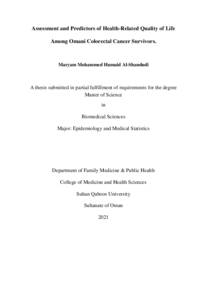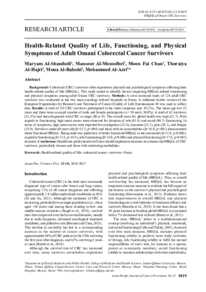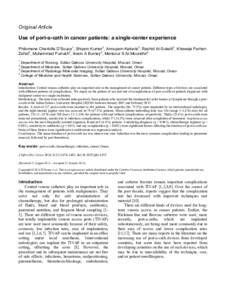Document
Assessment and predictors of health-related quality of life among Omani colorectal cancer survivors.
Other titles
جودة الحياة المتعلقة بصحة الناجين من سرطان القولون والمستقيم
Publisher
Sultan Qaboos University.
Gregorian
2021
Language
English
English abstract
Background: As the number of colorectal cancer survivors increases due to advances in
cancer therapy and the implementation of screening programmes, it has become essential
to understand and assess the quality of life (QOL) of cancer survivors after the completion
of treatment, particularly as the side-effects of such treatment can often have severe
physical, mental, and emotional consequences for affected patients. To the best of the
author's knowledge, this is the first study conducted in Oman to assess the QOL of cancer
survivors. The aim of this study was to evaluate QOL and identify factors affecting QOL
among adult Omani colorectal cancer patients who had survived a minimum of six months
following the completion of cancer therapy.
Methods: A cross-sectional study was conducted at the Sultan Qaboos University
Hospital and National Oncology Centre of the Royal Hospital, Muscat, Oman. A total of
124 Omani adult patients with colorectal cancer who had survived six months or longer
after the completion of treatment were recruited. Data collection was conducted between
August 2020 and February 2021. Relevant data were collected from the patients'
electronic medical records. In addition, two self-administered Arabic versions of
questionnaires originally developed by the European Organization for Research and
Treatment of Cancer (EORTC) to determine QOL among patients with general cancer
and colorectal cancer, respectively, were adapted for use in the population. Overall, the
questionnaires incorporated 59 items to determine the most distressing aspects of the
patients' QOL under functional and symptom-related subscales. Scoring for each item
was determined out of 100 according to the EORTC scoring manual, in which high scores
for the functioning subscales indicated better functionality, whereas high scores for the
symptom subscales indicated more severe and distressing symptoms. Subsequently, a
linear logistic regression analysis was used to determine factors predictive of QOL.
Results: A total of 118 out of 124 adult Omani colorectal cancer patients agreed to take
part in the study (response rate: 95.2%). The mean age was 52.7 ± 11.77 years (range:
26–80 years) and there was an equal number of male and female participants. The mean
score for global health status was 81.7. The highest scores in the functioning subscales
were obtained in the domains of role and social functioning (91.0 and 90.7, respectively).
For the general cancer symptoms subscale, the highest mean scores were observed for
constipation and insomnia (25.4 and 25.1, respectively), indicating that these symptoms
were considered most distressing by participants, with 11.0% of the patients complaining
of severe constipation and insomnia. In particular, men reported lower mean scores for
sexual interest in the functional subscale compared to women (31.4 versus 62.2).
Moreover, the highest score among men in the colorectal cancer-specific symptoms
subscale was impotence (35.9), with 16% of male patients complaining of severe
impotence. A total of 12 patients (10.2%) reported severe anxiety. Overall, age, gender,
the presence of comorbidities, and a diagnosis of colon and rectal cancer rather than
colorectal junction were found to be significant predicators of QOL (P ≤0.05 each).
Conclusion: This study showed that the overall QOL of Omani colorectal cancer
survivors was satisfactory, although certain deficits were identified in specific QOL
domains and symptoms. Thus, it is important for healthcare providers in Oman to conduct
regular assessments of colorectal cancer survivors after cancer treatment and implement
an individualised care plan for each survivor. Moreover, the findings of this study suggest
that more effective communication between patients and healthcare providers might be
helpful in order to allow survivors to more clearly express their concerns and experiences;
in addition, offering and referring patients for specialty counselling services could
contribute positively to improving the QOL of colorectal cancer survivors after recovery.
Member of
Resource URL
Arabic abstract
كلما زاد عدد المرضى الناجين من سرطان القولون والمستقيم كنتيجة لتطور علاجات السرطان بالاضافة الى الفحوصات الاستباقية كلما اصبحت الحاجة ملحة الى معرفة وفهم جودة الحياة لدى هؤلاء الناجين. وكما ان علاجات السرطان صعبة وتحتاج للتحدي فانه من الضروري استقصاء تأثير علاج السرطان على حياة المرضى وقد تعافوا من السرطان. في حد علمنا، إن هذه الدراسة هي الاولى من نوعها في قياس جودة الحياة عند العمانيين الناجين من السرطان. تهدف هذه الدراسة إلى قياس جودة الحياة عند مرضى سرطان القولون والمستقيم العمانيين الذين أكملوا ستة أشهر أو أكثر بعد إتمام علاج السرطان، كما تهدف لدراسة العوامل المؤثرة على جودة الحياة عند هذه الفئة من المرضى. الطريقة: أجريت دراسة مقطعية في مستشفى السلطان قابوس والمركز الوطني للأورام في المستشفى السلطاني في مسقط، سلطنة عمان. تمت دعوة جميع مرضى سرطان القولون والمستقيم ممن أنهوا علاجهم للسرطان بمدة تصل الى ستة أشهر أو أكثر للمشارك' في الدراسة. تم جمع البيانات بين أغسطس ٠٢٠٢م وفبراير ٠٢٠2 من خلال استبيانان ذاتيان الادارة. تم استخدام أداتين مقتبسة من المنظمة الاوروبية ألبحاث وعالج السرطان لتحديد جودة الحياة والاعراض الاكثر ازعاجا لدى المشاركين، عن طريق 95 عنصٍر محدٍد في مجالات وظيفية مختلفة والاعراض المختلفة التي من الممكن أن يعاني منها مريض السرطان. تم حساب عدد النقاط الحاصل عليها في الاستبانة عن طريق كتيب حساب النقاط الصادر من المنظمة الاوروبية ألبحاث وعالج السرطان. تم استخدام تحليل الانحدار لتحديد المتنبئات المستقلة لجودة الحياة. النتائج: وافق 221من أصل 2٠1 ناجيا من سرطان القولون والمستقيم على المشاركة في هذه الدراسة )معدل الاستجابة ٪59(. سجل مجال حالة الصحة الشاملة 1218 نقطة من أصل 2٢٢ نقطة. أعلى نقاط في المجال الوظيفي تم تسجيلها في وظيفية الادوار )5٢158 نقطة من أصل 2٢٢ نقطة( والوظيفية الاجتماعية )5٢18 نقطة من أصل 2٢٢ نقطة(. في مجال نقاط الاعراض تم تسجيل أعلى نقاط في مجال الامساك والارق )٠911 و ٠912 على التوالي( viii مما يعني أنها أكثر الاعراض ازعاجا للناجين. كما سجل حوالي %22 من الناجين امساكا وأرقا شديدين. سجل الاهتمام الجنسي لدى الرجال الناجين معدلا سيئا ومنخفضا بتسجيل 1211 نقطة من أصل 2٢٢ نقطة )تسجيل أقل من 1111 نقاط يعتبر سيء(. كما سجل أعلى نقاط في مجال الاعراض في ضعف الانتصاب لدى الرجال بمعدل 1915 من .2٢٢ )%21 من الرجال الناجين يعانون من ضعف شديد في الانتصاب(. كما رصدت الدراسة أن 2٢1٠ % من الناجين يعانون من قلق شديد. أظهر تحليل الانحدار أن العمر ووجود مرض أخر غير السرطان ووجود السرطان في القولون والمستقيم هي من العوامل المؤثرة في جودة الحياة
. الخلاصة: وجدت هذه الدراسة أن جودة الحياة لدى الناجين من سرطان القولون والمستقيم والذين كانوا في المراحل القابلة للشفاء التام جيدة على الرغم من بعض النواقص والاعراض التي ال زالوا يعانون منها تحت مجالات معينة. لذلك فان من الضروري على مقدم الرعاية الصحية ايلاء الاهتمام والتقييم المستمر لهؤلاء الناجين وتحديد خطة لكل ناجي شخصيا. بالاضافة الى الحاجة الى تواصل أكثر فعالية بين الناجين ومقدمي الرعاية الصحية للسماح للناجين بالتعبير عن تجربتهم حتى يكونوا أكثر قدرة في السيطرة على ضغوطهم العاطفية. كما أن تقديم الاستشارة المتخصصة المستهدفة لتحسين جودة الحياة يجب أن تكون مصممة ومتاحة لهؤالء الناجين.
. الخلاصة: وجدت هذه الدراسة أن جودة الحياة لدى الناجين من سرطان القولون والمستقيم والذين كانوا في المراحل القابلة للشفاء التام جيدة على الرغم من بعض النواقص والاعراض التي ال زالوا يعانون منها تحت مجالات معينة. لذلك فان من الضروري على مقدم الرعاية الصحية ايلاء الاهتمام والتقييم المستمر لهؤلاء الناجين وتحديد خطة لكل ناجي شخصيا. بالاضافة الى الحاجة الى تواصل أكثر فعالية بين الناجين ومقدمي الرعاية الصحية للسماح للناجين بالتعبير عن تجربتهم حتى يكونوا أكثر قدرة في السيطرة على ضغوطهم العاطفية. كما أن تقديم الاستشارة المتخصصة المستهدفة لتحسين جودة الحياة يجب أن تكون مصممة ومتاحة لهؤالء الناجين.
Category
Theses and Dissertations



